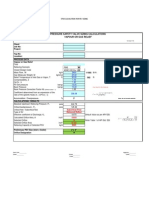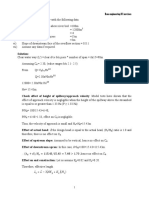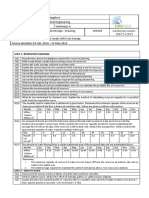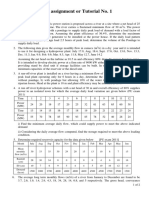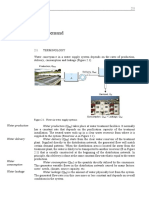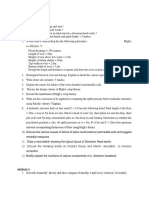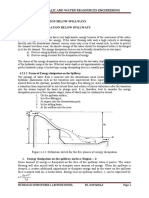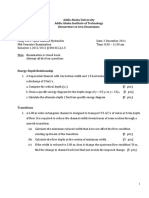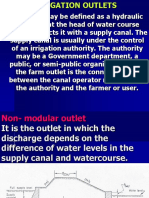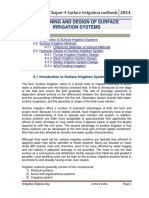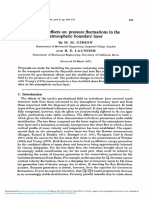Chapter 3 - Drip Irrigation
Chapter 3 - Drip Irrigation
Uploaded by
Eng Ahmed abdilahi IsmailCopyright:
Available Formats
Chapter 3 - Drip Irrigation
Chapter 3 - Drip Irrigation
Uploaded by
Eng Ahmed abdilahi IsmailOriginal Description:
Original Title
Copyright
Available Formats
Share this document
Did you find this document useful?
Is this content inappropriate?
Copyright:
Available Formats
Chapter 3 - Drip Irrigation
Chapter 3 - Drip Irrigation
Uploaded by
Eng Ahmed abdilahi IsmailCopyright:
Available Formats
Drip irrigation
Example: A typical orchard is to be developed on a field with dimensions of 253m by
439m. The orchard will be irrigated using a trickle system laid out so that each tree is served
by four emitters based on peak period requirements at full tree maturity. The following
additional information is provided.
a) operation pressure head at the emitter = 10m
b) peak period crop water requirement = 5mm/d
c) distribution pattern efficiency = 92%
d) operating time = 18h/d
Estimate the following design parameters.
a) Number of emitters required
b) Required emitter discharge, L/h
c) Length of lateral, m
Soln
From table 1 for ordinary orchard, plant density is 250 trees per hectare. Thus,
number of emitters required.
1ha 250trees
N = 253m * 439m * 2
* * 4 emitters/tree
10,000m ha
N = 11,108 emitters
- the equivalent application rate,
5mm / d
Gross application rate 0.92 0.302mm / h
da
application time 18h / d
- Required emitter discharge, in l/h
0.302m / h 1
q * 253m * 439m * 10 3 L 3 *
10 3
m 11,108emitters
q 3 .0 L
h …………For single emitter
From table 1, Lateral Length = 1900 m
ha
253m * 439m / ha
L=1900 m ha *
104
L = 21,103 m
Example problem 2
Determine the required diameter for an orifice emitter in a turbulent flow regime with a design
discharge of 10 l/h and operating pressure head of 10.0 m. Assume a value of 0.6 for the orifice
coefficient.
Solution: Applying Eqn : (5),
Q = 3.6 (A) (0.6) 2 * 9.807 *10 = 30.26A
Substituting the design discharge and solving for the cross- sectional area and hence the diameter,
Lecture Supporting Materials By Negash Wagesho 2009 1
Drip irrigation
Q 10.0 L / h D 2
A= = 0.3305 mm2 =
30.26 30.26 4
D = 0.65 mm
Example problem 3
Compute the required length of a long-path emitter for a system with a design discharge of 4.0
L/h and operating pressure head of 10.0m using smooth plastic micro-tubing with an inside
diameter of 1.0mm. Assume the standard value of 1.0 x 10-6 m2/s for the kinematic viscosity of
water.
Solutions: Compute the Reynold’s number using equation…... to determine the flow
regime.
4 *10 3
q
V= = 3600 sec = 1.4147m/s
A * (0.001m) 2
4
1.414 m (1.0)m
RN = s
10 (1.0 x10 6 m 2 / s )
3
RN = 1415 < 2000
Therefore the flow is laminar. Compute the friction factor using Eq, (4)
64
f= = 0.0452
1415
Substituting into Eq. (2), the only unknown is the length of micro-tubing.
0.5
HD
Q = 0.11384(A) 2 g ( )
fL
0 .5
(1.0mm) 2
4.0L/h = 0.11384 2(9.807 m / s 2 10.0m(1.0mm
4 0.0452 L
L = 1.472
L = 2.167m
Example problem 4.
Compute the required length of a long-path emitter for the same system as that given in example
problem 3,except that the design discharge is 28 L/h
Solution:
Compute the Reynolds number for this flow regime. Since the Reynolds number is a linear
function of flow velocity and the velocity is directly proportional to the discharge, we can set up
the Reynolds number as a function of that computed in example problem 3
28 L / h
RN = 1415 = 9905
4 .0 L / h
Assume a flow regime will be fully turbulent at this high Reynolds number. Apply Eq. (5) for the
friction factor. Use the value of from table 2 for plastic equal to 0.003 mm for the absolute
roughness.
1 D
= 2 log 1.14
f
Lecture Supporting Materials By Negash Wagesho 2009 2
Drip irrigation
1
f
= 2 log (1.0mm/0.003mm) +1.14
f = 0.0261
Substituting into e.q. (3) and solving for emitter length,
0.5
H D
A 2 g
fL
Q = 0.1138
0.5
2(9.807m / s 2
10.0m (1.0mm)
28.0 L/h = 0.11384(0.7854mm2)
0.0261L
L= 0.0242 m
Fig.2 : Discharge rates for various emitter designs as a function of operating head.
Example Problem 5
A trickle system is to be designed for an established orchard in which the field slope is greater
than 2 percent and spacing between trees is greater than 4 m. Four point source emitters
corresponding to long-path-type C ….are to be used per tree. Design emitter discharge is 8.0 L/h
and the manufacturer’s coefficient of variation is 0.08.
Compute the minimum emitter discharge and corresponding minimum emitter pressure.
Solution:
From ASAE Standards in Table 5 the minimum design emission uniformity is
Uc-min = 85 percent
Substituting problem variables into eqn. (6) for emission uniformity.
85 = 100 [1.0 – (1.27/4)0.08] [qmin/( 8.0L/h] ,Solving for qmin,
qmin = 8.0 L/h(0.85)/0.9746
qmin = 6.977 = 7 L/h
Referring figure 2, for long path Type – C emitter for q = 7 l/h , H min = 5m. This is the minimum
pressure head required on the lateral to maintain the design standards for emission uniformity.
If measured value of Cv , qmin and qavg are substituted in to eqn. 6 , the result is the field emission
uniformity. Specific procedures have been established so results from different fields are
comparable.
Lecture Supporting Materials By Negash Wagesho 2009 3
Drip irrigation
Example Problem 6
A lateral is to be designed for a vineyard with 30 single orifice emitters along the line . The
lateral is 10 mm in diameter. The emitters are spaced 1.0 m apart with the first emitter at one full
space from the lateral entrance from the sub main. The field surface is level; A secondary
pressure regulator maintains a pressure head of 10.0m at the entrance to the lateral which
corresponds to a design emitter discharge of 12 l/h. Calculate the discharge of the final emitter on
the lateral using Fig.2 for the discharge to pressure relationship.
Solution:
Compute the total discharge on the lateral.
l l
Q = N(q) = 30(12.0 ) = 360
h h
Compute the flow velocity and Reynolds number to verify the flow regime assuming the standard
value of dynamic viscosity.
360 * 10 3 m 3
Q
= 3600 sec = 1.2732 m
V=
A
* 10 * 10 3
2
s
4
Substituting into eqn. ** for the Reynolds number,
1.2732 m * 10 * 10 3 m
VD s
RN = = m2 = 12,372
1.0 * 10 6
s
Flow is therefore fully turbulent. Compute the friction factor for smooth
n
plastic using eq .5
1
f
= 2 log (10mm/0.003mm) + 1.14
f = 0.0149
Compute the friction head loss in the lateral for all flow passing through the lateral using eqn.10.
hf = 6.377(0.0149) (30 m) (360 L/h)2/ (10 mm)5
hf = 3.70 m
Compute the actual friction head loss accounting for discharge through the emitters. Apply the
Christiansen friction factor from Table 7-12 (or using equations) for first discharge point one full
spacing from the entrance with m = 2 and N = 30
F = 0.350
hac = 0.350(3.700 m) = 1.30 m
Since the field is level, the actual friction head loss equals the total head loss on the lateral.
Calculate the operating pressure head at the last emitter in the lateral.
Hfinal = 10.0 m -1.30m = 8.7 m
Referring to Fig. 2 ( type – A) for an orifice emitter and pressure head of 8.7 m.
q = 11 L/h
The total variation of discharge in percent along the lateral as a ratio of the design discharge is
therefore ,
12 L / h 11L / h
q=
12 L / h
q = 8.3 % ……… acceptable !!!!
Lecture Supporting Materials By Negash Wagesho 2009 4
Drip irrigation
Lecture Supporting Materials By Negash Wagesho 2009 5
You might also like
- Pressure Safety Valve Sizing Calculation Rev.01Document3 pagesPressure Safety Valve Sizing Calculation Rev.01Alvin Smith100% (11)
- Chapter 2Document149 pagesChapter 2zelalemniguse75% (4)
- Chap 2 - Sprinkler IrrigationDocument4 pagesChap 2 - Sprinkler IrrigationEng Ahmed abdilahi Ismail100% (1)
- Examples (Sediment Transport) AUTUMN 2018Document6 pagesExamples (Sediment Transport) AUTUMN 2018orlaandoNo ratings yet
- Revision Questions: Introduction + Irrigation SystemsDocument11 pagesRevision Questions: Introduction + Irrigation SystemsKiprop VentureNo ratings yet
- Wrie Iii Prepared By: Yassin Y. Dam Engineering II ExercisesDocument6 pagesWrie Iii Prepared By: Yassin Y. Dam Engineering II ExercisesWalterHu100% (1)
- Improvement of IEC 60534-8-3 Standard Fo PDFDocument12 pagesImprovement of IEC 60534-8-3 Standard Fo PDFDenon EvonNo ratings yet
- Hydraulics: 6.1. Headworks For River Water OfftakeDocument50 pagesHydraulics: 6.1. Headworks For River Water OfftakesuonsovannakaNo ratings yet
- Design of Non-Erodible CanalsDocument43 pagesDesign of Non-Erodible CanalsLee CastroNo ratings yet
- Numerical My BookDocument47 pagesNumerical My BookKiran Ghimire100% (1)
- Summarizing Data - Statistical HydrologyDocument6 pagesSummarizing Data - Statistical HydrologyJavier Avila100% (1)
- 10CV65 - Hydraulic Structures and Irrigation Design - Drawing Question BankDocument6 pages10CV65 - Hydraulic Structures and Irrigation Design - Drawing Question BankMr. Y. RajeshNo ratings yet
- Assignment 2 Sediment - FinalDocument12 pagesAssignment 2 Sediment - FinalzelalemniguseNo ratings yet
- Home Assignment or Tutorial No 1-2020Document3 pagesHome Assignment or Tutorial No 1-2020Maniraj ShresthaNo ratings yet
- Tutorial On Sediment Transport Mechanics: April, 2020Document15 pagesTutorial On Sediment Transport Mechanics: April, 2020zelalemniguse100% (1)
- Design of Irrigation Canal Problem PDFDocument11 pagesDesign of Irrigation Canal Problem PDFQushik Ahmed ApuNo ratings yet
- 4 - HE 731 - Example - Surge Tank and TurbinesDocument11 pages4 - HE 731 - Example - Surge Tank and TurbinesHa NaNo ratings yet
- Swat Weather Database: A Quick GuideDocument14 pagesSwat Weather Database: A Quick GuideLimber Trigo Carvajal100% (1)
- Hydraulics and Hydrology of Hydropower Solved Problems and AssignmentDocument16 pagesHydraulics and Hydrology of Hydropower Solved Problems and AssignmentFola BayanNo ratings yet
- Velocity of Flow: Er. Sandip BudhathokiDocument64 pagesVelocity of Flow: Er. Sandip BudhathokiManmohan Singh KhadkaNo ratings yet
- Name: - Maulid Adem Siyad ID: - 0211/12 Assignment - 2Document7 pagesName: - Maulid Adem Siyad ID: - 0211/12 Assignment - 2Maulid100% (1)
- Hydrology NumericalsDocument2 pagesHydrology NumericalsGangadharsimaNo ratings yet
- WeirsDocument6 pagesWeirsJessicalba LouNo ratings yet
- Sub Theme 2 - Full PaperDocument752 pagesSub Theme 2 - Full PaperDedi ApriadiNo ratings yet
- Water Work ch-2Document100 pagesWater Work ch-2Zekarias TadeleNo ratings yet
- Chapter 5Document46 pagesChapter 5Eba Getachew100% (1)
- The Average Monthly Flow of A Stream in A Dry YearDocument5 pagesThe Average Monthly Flow of A Stream in A Dry Yearyasir_mushtaq78675% (4)
- Consumptive Use of IrrigationDocument102 pagesConsumptive Use of IrrigationHasanur Rahman Mishu100% (1)
- Water Demand: Water Production (Q Water ProductionDocument34 pagesWater Demand: Water Production (Q Water ProductionAyele ErmiyasNo ratings yet
- Notes Answers PDFDocument39 pagesNotes Answers PDFkbkwebs0% (1)
- Assignment 1Document3 pagesAssignment 1Amanuel Enawgaw Amogehegn100% (2)
- Ce302 - Dhs Question BankDocument5 pagesCe302 - Dhs Question Banksyamak0% (1)
- 1 - HE 731 - Example - Canal SurgesDocument6 pages1 - HE 731 - Example - Canal SurgesHa NaNo ratings yet
- Example Problem: Unit HydrographDocument6 pagesExample Problem: Unit HydrographMaitrabarun KarjeeNo ratings yet
- Irrigation Engineering FormulaeDocument32 pagesIrrigation Engineering Formulaemirab89100% (1)
- Assignment IDocument4 pagesAssignment IAmexTesfayeKoraNo ratings yet
- Engineering HydrologyDocument2 pagesEngineering Hydrology11520035100% (1)
- Basics For Rural ConstructionDocument83 pagesBasics For Rural ConstructionBernard Palmer100% (1)
- Practical PDFDocument77 pagesPractical PDFsyamkavithaNo ratings yet
- Gravity DamDocument64 pagesGravity DamsubxaanalahNo ratings yet
- 3 3 3 .2 Design Discharge .3 Stream/River Training Works: Improvement of Cross-Section Channel Rectification DykesDocument90 pages3 3 3 .2 Design Discharge .3 Stream/River Training Works: Improvement of Cross-Section Channel Rectification Dykesyobek100% (1)
- Steel Structure AssignmentDocument11 pagesSteel Structure AssignmentGetaneh HailuNo ratings yet
- Open TutorialDocument2 pagesOpen Tutorialeph86% (7)
- 7 Gravity DamsDocument35 pages7 Gravity Damskishing0905100% (1)
- River Engineering AssignmentDocument4 pagesRiver Engineering AssignmentChanako Dane100% (1)
- Irrigation Engineering - PCJDocument276 pagesIrrigation Engineering - PCJSamundra LuciferNo ratings yet
- Assignments-Design of Dam Appurtenant Structures-2022Document2 pagesAssignments-Design of Dam Appurtenant Structures-2022Marew Getie100% (2)
- Worksheet OneDocument4 pagesWorksheet OneRefisa JiruNo ratings yet
- Ju, Jit, Hydralic and Water Reasources Engineering: Energy Dissipation Below Spillways Energy Dissipation Below SpillwaysDocument14 pagesJu, Jit, Hydralic and Water Reasources Engineering: Energy Dissipation Below Spillways Energy Dissipation Below SpillwaysRefisa JiruNo ratings yet
- Worked Examples Using Nomographs and Colebrook ChartsDocument5 pagesWorked Examples Using Nomographs and Colebrook ChartsNickson Koms100% (1)
- Aliran TransienDocument7 pagesAliran Transienmdalimunthe_3No ratings yet
- Design of Contour & Graded Bunds-1Document22 pagesDesign of Contour & Graded Bunds-1roy4gaming.ytNo ratings yet
- Ceng 3601-Mid ExamDocument2 pagesCeng 3601-Mid ExamRefisa Jiru100% (1)
- Presentation On Determination of Water Potential of The Legedadi CatchmentDocument25 pagesPresentation On Determination of Water Potential of The Legedadi Catchmentashe zinabNo ratings yet
- OutletsDocument107 pagesOutletsNumair Ahmad FarjanNo ratings yet
- 2016 Bookmatter IrrigationAndDrainageEngineeri PDFDocument180 pages2016 Bookmatter IrrigationAndDrainageEngineeri PDFJohn Paul EspañoNo ratings yet
- Unesco 1979Document53 pagesUnesco 1979pleyvaze100% (1)
- Anley Assignment1Document19 pagesAnley Assignment1banitessew82100% (1)
- Chapter 6. Surface Irrigation MethodsDocument33 pagesChapter 6. Surface Irrigation MethodsReffisa JiruNo ratings yet
- Irrigation Engineering Worksheet-One: A) Porosity (45.06%) ) )Document1 pageIrrigation Engineering Worksheet-One: A) Porosity (45.06%) ) )Reffisa Jiru100% (2)
- Ecohydrology: Vegetation Function, Water and Resource ManagementFrom EverandEcohydrology: Vegetation Function, Water and Resource ManagementNo ratings yet
- 5 1Document2 pages5 1Kerlos SaeedNo ratings yet
- Alemu Molla PDFDocument89 pagesAlemu Molla PDFEng Ahmed abdilahi IsmailNo ratings yet
- Ahmed Abdilahi Ismail Applied Hydrology AssignmentDocument12 pagesAhmed Abdilahi Ismail Applied Hydrology AssignmentEng Ahmed abdilahi IsmailNo ratings yet
- Surface Irrigation Design Assignment Ahmed Abdilahi IsmailDocument16 pagesSurface Irrigation Design Assignment Ahmed Abdilahi IsmailEng Ahmed abdilahi IsmailNo ratings yet
- Ahmed Abdilahi Ismail Assignment SurfaceDocument15 pagesAhmed Abdilahi Ismail Assignment SurfaceEng Ahmed abdilahi IsmailNo ratings yet
- Surface Irrigation ManualDocument279 pagesSurface Irrigation ManualEng Ahmed abdilahi IsmailNo ratings yet
- L0 - Course OverviewDocument19 pagesL0 - Course OverviewEng Ahmed abdilahi IsmailNo ratings yet
- Basics of F95 - LNDocument46 pagesBasics of F95 - LNEng Ahmed abdilahi IsmailNo ratings yet
- Dokumen - Tips Tube Wells and Their DesignDocument60 pagesDokumen - Tips Tube Wells and Their DesignEng Ahmed abdilahi IsmailNo ratings yet
- Chapter One DamDocument36 pagesChapter One DamEng Ahmed abdilahi IsmailNo ratings yet
- WRIE 813 Sprinkler and Trickle Irrigation System Analysis - Lecture 1Document4 pagesWRIE 813 Sprinkler and Trickle Irrigation System Analysis - Lecture 1Eng Ahmed abdilahi IsmailNo ratings yet
- WRSP JjuDocument344 pagesWRSP JjuEng Ahmed abdilahi IsmailNo ratings yet
- Tube Well Design Project SolutionDocument5 pagesTube Well Design Project SolutionEng Ahmed abdilahi IsmailNo ratings yet
- The Islamic University of Gaza Faculty of Engineering Civil Engineering Department Infrastructure MSCDocument48 pagesThe Islamic University of Gaza Faculty of Engineering Civil Engineering Department Infrastructure MSCEng Ahmed abdilahi IsmailNo ratings yet
- Assignment-One Advanced Surface Irrigation System DesignDocument2 pagesAssignment-One Advanced Surface Irrigation System DesignEng Ahmed abdilahi IsmailNo ratings yet
- Chapter 3-Surface Irrigation DesignDocument68 pagesChapter 3-Surface Irrigation DesignEng Ahmed abdilahi IsmailNo ratings yet
- MS2019Document2 pagesMS2019herewego759No ratings yet
- Marine ValvesDocument217 pagesMarine ValvesDuongNo ratings yet
- ابزاردقیق - مخفف تجهیزات ابزاردقیقDocument3 pagesابزاردقیق - مخفف تجهیزات ابزاردقیقSepideNo ratings yet
- ValvesDocument108 pagesValvesGautam Wayse100% (1)
- Upang Cea 4bsce Cie095 P2Document58 pagesUpang Cea 4bsce Cie095 P2Wheng JNo ratings yet
- Compressible Flow PDFDocument38 pagesCompressible Flow PDFApple EmiratessNo ratings yet
- From Drawing: No. M-U-PW-01Document1 pageFrom Drawing: No. M-U-PW-01Tôn Huỳnh ĐoànNo ratings yet
- Linear Pressure Strain - 1Document21 pagesLinear Pressure Strain - 1Archie PapNo ratings yet
- LC HPM 280型手动泵说明书Document9 pagesLC HPM 280型手动泵说明书DariusNo ratings yet
- Fluid Mechanics II-course Guide Book - 2023 - ASTUDocument3 pagesFluid Mechanics II-course Guide Book - 2023 - ASTUgediontassew007No ratings yet
- Data Sheet 4.0HP MVN-4 16TR TCV 1 PUMPSETDocument3 pagesData Sheet 4.0HP MVN-4 16TR TCV 1 PUMPSETrifanderiNo ratings yet
- Hydraulics' Quiz No. 2 - Module 4-5 - Google FormsDocument7 pagesHydraulics' Quiz No. 2 - Module 4-5 - Google FormsFrancis HernandezNo ratings yet
- Chapter 2 by SahuDocument29 pagesChapter 2 by SahuJahangir AliNo ratings yet
- Quick Return Mechanism For Shaper Machine (Hydraulic Circuit)Document12 pagesQuick Return Mechanism For Shaper Machine (Hydraulic Circuit)Rushikesh BachhavNo ratings yet
- Fire Pump Test Diesel 2012Document3 pagesFire Pump Test Diesel 2012Diego Anaya100% (1)
- 4th - Flow Across Banks of TubesDocument16 pages4th - Flow Across Banks of TubesPrakash AchyuthanNo ratings yet
- 1ab367c9 PDFDocument88 pages1ab367c9 PDFRS Rajib sarkerNo ratings yet
- Gas Well Deliverability I 2018Document33 pagesGas Well Deliverability I 2018Johny Imitaz0% (1)
- Chapter 4-Introduction To Aeroelasticity 20222023Document12 pagesChapter 4-Introduction To Aeroelasticity 20222023ABDELRAHMAN REDA MAAMOUN ELSAID SEYAM A19EM0638No ratings yet
- 5MM Bore DMF Monoflange Flange X ScrewDocument1 page5MM Bore DMF Monoflange Flange X ScrewgeevenNo ratings yet
- Wingtip Vortex: Team A2 Aero 3BDocument15 pagesWingtip Vortex: Team A2 Aero 3BAkshat JaniNo ratings yet
- Saudi Aramco Requirements Technical Links, Comments & ExceptionsDocument2 pagesSaudi Aramco Requirements Technical Links, Comments & ExceptionsJohn BuntalesNo ratings yet
- PmsDocument94 pagesPmssdk1978100% (1)
- Check Valves My Notes and CalculationsDocument3 pagesCheck Valves My Notes and CalculationsMohamed RashedNo ratings yet
- Guide To Steel Pipes For Vessels - Wide Flange Beams ExcelDocument195 pagesGuide To Steel Pipes For Vessels - Wide Flange Beams ExcelAlmario SagunNo ratings yet
- Classification of Flows: AE 225 - Incompressible Fluid MechanicsDocument19 pagesClassification of Flows: AE 225 - Incompressible Fluid MechanicsHarry MoreNo ratings yet
- Slug Catcher Conceptual DesignDocument8 pagesSlug Catcher Conceptual Designfanziskus100% (1)
- Problem Set 3Document1 pageProblem Set 3lava_lifeNo ratings yet
